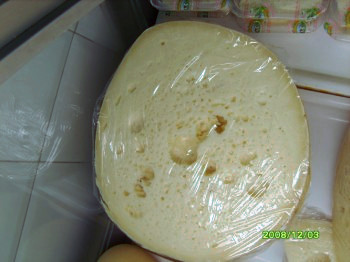Pallone di Gravina on:
[Wikipedia]
[Google]
[Amazon]
 The Pallone di Gravina is a firm, semi-hard, cow's milk cheese from the regions of Basilicata and Apulia in south-east
The Pallone di Gravina is a firm, semi-hard, cow's milk cheese from the regions of Basilicata and Apulia in south-east
 The rind is hard, smooth and straw-coloured, becoming browner with age; the body, firm in texture, and also starts out straw-yellow, but turns golden as the cheese matures. Pallone di Gravina is at its best after being aged for at least twelve months.‘Pallone di Gravina’
The rind is hard, smooth and straw-coloured, becoming browner with age; the body, firm in texture, and also starts out straw-yellow, but turns golden as the cheese matures. Pallone di Gravina is at its best after being aged for at least twelve months.‘Pallone di Gravina’
, ''Ars Alimentaria'': a databank of information and documentation concerning Italian food quality standards and safety. ‘Pallone di Gravina’
''Arca del Gusto'', Slow Food Foundation. The basic ingredient is full cream cow's milk, which may be
 The Pallone di Gravina is a firm, semi-hard, cow's milk cheese from the regions of Basilicata and Apulia in south-east
The Pallone di Gravina is a firm, semi-hard, cow's milk cheese from the regions of Basilicata and Apulia in south-east Italy
Italy ( it, Italia ), officially the Italian Republic, ) or the Republic of Italy, is a country in Southern Europe. It is located in the middle of the Mediterranean Sea, and its territory largely coincides with the homonymous geographical ...
. It is made in the ''pasta filata
(Italian: "spun paste") is a technique in the manufacture of a family of Italian cheeses also known in English as stretched-curd, pulled-curd, and plastic-curd cheeses. Stretched curd cheeses manufactured from the pasta filata technique undergo ...
'' style weighing between , in a pear-like shape, ball or balloon (''pallone''), and was traditionally produced in the area of the city of Gravina, in the Murgia area of the province of Bari
The Province of Bari ( it, provincia di Bari, nap, pruvincia 'e Bari, nap, label= Barese, provinge de Bare) was a province in the region of Apulia, Italy. Its capital was the city of Bari.
It has an area of , and a total population of 1,594,1 ...
. Today, however, production is centred on the province of Matera
The province of Matera ( it, Provincia di Matera; Materano: ) is a province in the Basilicata region of Italy. Its capital is the city of Matera. It has an area of and a total population of 201,133; the city Matera has a population of 61,204. Th ...
.
In 2016 the comune
The (; plural: ) is a local administrative division of Italy, roughly equivalent to a township or municipality. It is the third-level administrative division of Italy, after regions ('' regioni'') and provinces (''province''). The can also ...
of Gravina made an application for the cheese to receive PDO status within the European Union
The European Union (EU) is a supranational political and economic union of member states that are located primarily in Europe. The union has a total area of and an estimated total population of about 447million. The EU has often been de ...
.
In 2012 has been recognized as Slow Food Presidia, from Slow Food International organization, thanks to the work made by Mr. Antonio Cucco Fiore, MBA.
Description
 The rind is hard, smooth and straw-coloured, becoming browner with age; the body, firm in texture, and also starts out straw-yellow, but turns golden as the cheese matures. Pallone di Gravina is at its best after being aged for at least twelve months.‘Pallone di Gravina’
The rind is hard, smooth and straw-coloured, becoming browner with age; the body, firm in texture, and also starts out straw-yellow, but turns golden as the cheese matures. Pallone di Gravina is at its best after being aged for at least twelve months.‘Pallone di Gravina’, ''Ars Alimentaria'': a databank of information and documentation concerning Italian food quality standards and safety. ‘Pallone di Gravina’
''Arca del Gusto'', Slow Food Foundation. The basic ingredient is full cream cow's milk, which may be
pasteurised
Pasteurization American and British English spelling differences#-ise, -ize (-isation, -ization), or pasteurisation is a process of food preservation in which packaged and non-packaged foods (such as milk and fruit juices) are treated with mi ...
or not, and may come from one or two milkings. The curdling agent can be liquid calves’ rennet or a paste derived from the stomachs of kid goats or lambs. The third ingredient is salt.
Production
The method of production is similar to that ofcaciocavallo
Caciocavallo is a type of stretched-curd cheese made out of sheep's or cow's milk. It is produced throughout Southern Italy, particularly in the Apennine Mountains and in the Gargano peninsula. Shaped like a teardrop, it is similar in taste to ...
. The milk is warmed and curdled with the rennet and the curds are placed in a ''tompagno'': a perforated basket similar to a colander. After two or three hours, when the required level of acidity has been reached, the coagulate is sliced up and ‘spun’ in hot water. (See ''pasta filata
(Italian: "spun paste") is a technique in the manufacture of a family of Italian cheeses also known in English as stretched-curd, pulled-curd, and plastic-curd cheeses. Stretched curd cheeses manufactured from the pasta filata technique undergo ...
''.) The pieces are then moulded by hand into their characteristic shape. After salting in brine for 12 to 20 hours (depending on their size), the ‘balloons’ are set to dry for 15 days in the dairy where they were shaped, and then transferred to the cellar to mature.
See also
* *References
{{Italian cheeses Cow's-milk cheeses Stretched-curd cheeses Lucanian cheeses Cuisine of Apulia Basilicata